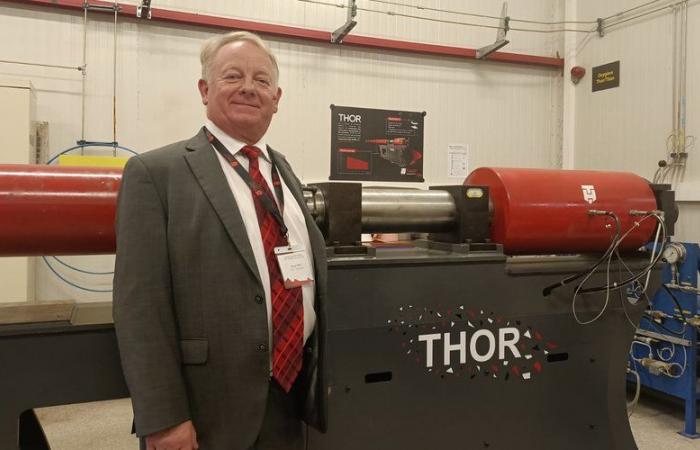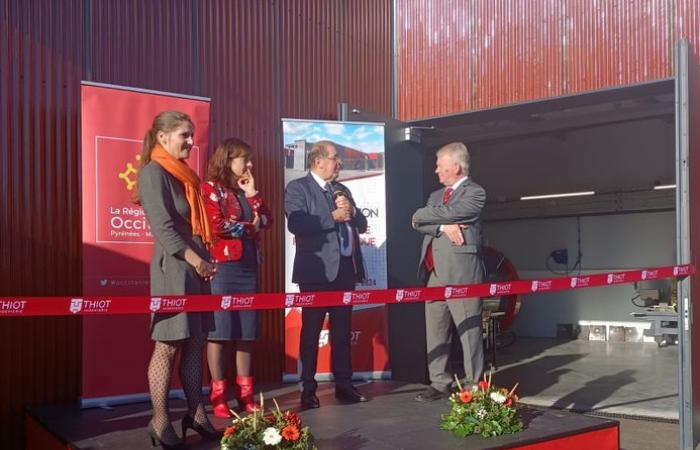the essential
It's not every day that you get to visit such a company. On the occasion of the inauguration of their new pyrotechnic laboratory, Thiot Ingénierie, a company specializing in shock physics in Puybrun, opened its doors. Reporting.
Who could have suspected that a company at the forefront of technology and innovation would be hiding in the Lot? However, it is in Puybrun that, for more than thirty years, Thiot Ingénierie has continued to grow. A large red building on the side of the road which houses many technological feats. This company specializes in shock physics and has a research and testing laboratory unrivaled in the world. It has risen to the rank of world leaders in the manufacture of equipment intended for the study of the behavior of materials subjected to high deformation rates.
Also read:
In the Lot: Thiot Ingénierie, a company that knows how to withstand shocks
This Thursday, Patrick Thiot, former engineer at CEA de Gramat and founder of the company, opened the doors of his company for an exceptional visit, all on the occasion of the inauguration of their new pyrotechnic laboratory, Poseidon. The latter will make it possible to study the interactions between structures and explosive materials. For example, measuring the effects of attacks on buildings. A big step forward for the laboratory which previously focused on inert (non-explosive) materials. “I am proud of our technical and scientific progress, and this will continue for the next thirty years,” smiles the president.
Space debris: a real concern
To begin, a quick visit to the new laboratory, the first tests of which will take place at the end of the first quarter of 2025. Prohibition on taking photos and videos: it is still confidential. But let the people of Lot rest assured: security is assured. “The church tower will stay in place! », laughs Patrick Thiot.
DDM Aouregan Texier
Heading towards Hermès, installed on the first floor of the building. All of the company's machines have the name of a Greek deity. “It’s a tradition,” comments the founder. When we enter the room, we face an imposing gray construction. This is a double stage gas launcher. It makes it possible to test the behavior of certain materials and structures at very high impact speeds. It is even the most efficient in its category: it launched at more than 38,000 km/h. This machine is used, in particular, for all space debris. “This is a real problem that worries the authorities. For example, when two satellites collide, it creates debris. And these can, again, collide with something else. There are risks, and we must be able to measure them. The speeds in orbit are of this order,” maintains an engineer. And for that, we must first measure the impacts. In a display case at the entrance to the room is a multi-story construction of very thin plates. “When we think about stopping space debris, we think that we need a lot of material, something compact. Whereas that’s the most effective, something well ventilated,” continues the engineer. And next to it sits a figurine of Arnold Schwarzenegger, who clearly did not appreciate one of the company's tests… In addition to space, Thiot Ingénierie also works with the aeronautics and defense sectors.
800 shots each year
Return to the ground floor of the laboratory. And there, a surprising statistic: one gun barrel (for military tanks in particular) in two in the world passed through a machine invented by the Lot company. “The goal of a cannon is to do as much damage as possible while staying as far away from the enemy. We can hit a target 40 kilometers away with a 40 kg shell. From here, you can reach Aurillac or Tulle! », explains the engineer. This is possible thanks to the autofrettage machine designed by Thiot: its aim is to subject the tube to enormous pressure to be sure that it does not deform or subsequently explode.
The tests carried out by Thiot are quite expensive. The company can carry out certain digital simulations. This helps avoid having to pay money for a test. “When you make one, you can’t go wrong. There is always a feasibility shot before moving on to the customer test,” says Claire, who receives us in the order control room. It is from this space that the tests are ordered. “Everyone is here. The areas are closed, and we have flashing lights to signal this, as well as an audible alarm, in particular to warn the offices, because the tests can sometimes make a little noise. » An element confirmed by the mayor of Puybrun, who lives nearby and who sometimes hears muffled noises. On average, over a year, 800 shots are carried out. “We can do up to six per day when the target is not too complicated to set up. Last time, we took three weeks for a shot,” continues Valérie.
DDM Aouregan Texier
The visit ends with the Thor and Titan launchers, as well as the “casemate”. Most shots are carried out in confined detonation chambers, but sometimes they are carried out in this adapted room. This makes it possible to test larger elements, such as a helicopter cockpit. “The area adapts to customer demand. We don’t deny ourselves much,” smiles the founder. Once the premises have been visited, return outside. Opposite, a vacant lot. “It’s ours. In the years to come, we would like to move some machines there to expand our laboratory,” confides Patrick Thiot. Enough to make Lotois engineering shine.







